Highway 289 is a designation for two north–south state highways in north central Arkansas. A southern route of 4.93 miles (7.93 km) runs north from Highway 69B (AR 69B) at Sage to Zion. A second route of 37.89 miles (60.98 km) begins at Highway 56 in Franklin and runs north to Highway 9 in Mammoth Spring.
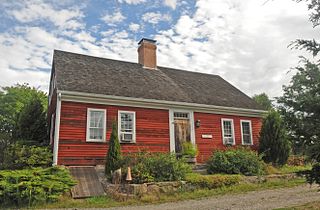
The Capt. Mark Stoddard Farmstead is a historic house at 24 Vinegar Hill Road in the Gales Ferry section of Ledyard, Connecticut. Built about 1770, it is a well-preserved example of a rural Cape style farmhouse, whose preservation includes its remote rural setting. The property was listed on the National Register of Historic Places in 1992.
Smith Farm or Smith Farmhouse or variations may refer to:

Philip Friend House is a c. 1807 historic farm house in North Bethlehem Township, Pennsylvania, US. The stone house is forty feet by thirty feet, two-story, five-bay, and gable-roofed. Contributing outbuildings include a barn, springhouse, wash house, and privy.

The Sellers Farm was a historic farmstead in Maysville, Arkansas. The main house was a two-story I-house, with a rear wing giving it an overall T configuration. The main facade faced west, and was covered by a porch that extended the full width on the first floor, and for three of the five bays on the second. There was a front-facing gable above the three center bays. Built c. 1910, it was an example of a little-altered I-house. Outbuildings on the property included a feed barn, chicken house, milk shed, and privy. All of the buildings on the property were in Arkansas; the associated land extended into neighboring Oklahoma.

Mount Olive Cumberland Presbyterian Church is one of the oldest existing congregations west of the Mississippi River and its historic church building at the junction of Izard County Roads 12 and 18 in Mount Olive, Arkansas is listed with the National Register of Historic Places. The pastor is Rev. Christopher S. Anderson.
Eight auxiliary routes of Arkansas Highway 69 currently exist. Four are spur routes, with four serving as business routes.
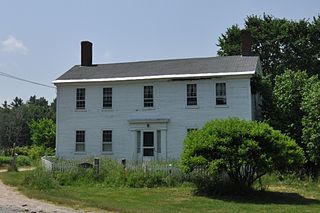
The Plummer Homestead is a historic house museum at 1273 White Mountain Highway in Milton, New Hampshire. Built in the 1810s and repeatedly extended, it dates to the early settlement period of Milton, and is, along with the adjacent Plumer-Jones Farm, one of the oldest farm properties in the state. Both are now part of the New Hampshire Farm Museum. The house was listed on the National Register of Historic Places in 2002.

The Arnold Springs Farmstead is a historic farmstead on Jennings Lane on the northwest edge of Melbourne, Arkansas. The farmhouse on the 5-acre (2.0 ha) property is a log structure clad in weatherboard, whose construction has been dated to the mid-1850s. It was originally built as a dogtrot, which was enclosed in the late 19th century. The exterior of the house has vernacular Greek Revival styling, also applied in the late 19th century. The property also includes a collection of 19th- and early 20th-century agricultural outbuildings, as well as an early stone wall and bridge. Sited near a locally significant fresh-water spring, the site served as a tavern and traveler's rest stop for many years.

The Izard County Courthouse is located at Courthouse Square and Arkansas Highway 69 in Melbourne, the county seat of Izard County, Arkansas. It is a two-story structure, built of rusticated gray limestone, with modest Art Deco styling. The grounds include a World War I memorial featuring a marble doughboy statue erected in 1930 in front of the courthouse. It was built in 1938–1940 by crews from the National Youth Administration. It is the county's fourth courthouse, two of the first three having been destroyed by fire.
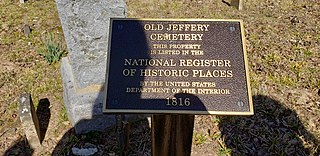
The Jeffery Cemetery is a historic cemetery in rural western Izard County, Arkansas. It is located on a knoll overlooking the White River, about 1 mile (1.6 km) north of Mount Olive, and is less than one acre in size. It has sixteen marked burial sites, and another ten to twenty that have no marking. The earliest dated burial occurred in 1816, and the latest in 1908. The cemetery is located on land granted to Jehoiada Jeffery for his service in the War of 1812, and is the only surviving site associated with his life. Jeffery is the first known permanent white settler in north central Arkansas.
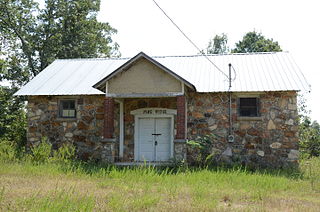
The Pine Ridge School Building is a historic school building in rural Izard County, Arkansas. It is a single-story fieldstone structure, located on the south side of Pine Ridge Road about 0.5 miles (0.80 km) west of Brockwell. It was built c. 1920, fashioned out of uncoursed native sandstone with grapevine mortar joints. A central gable-roofed entrance portico extends from the center of the building's north facade. It is a fine local example of an early 20th-century one-room school building.
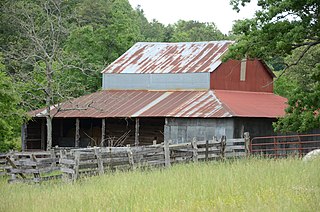
The Rector Log Barn is a historic barn in rural Izard County, Arkansas. It is located on the Rector Plantation, at the end of County Road 218, northwest of Melbourne. Its central portion, a log structure 2-1/2 stories in height, was built c. 1855, and is the only known example in the region of an antebellum era log barn. The main structure is flanked on all sides by 20th-century single-story shed-roof extensions, which serve in part to protect the historic log elements. The barn was built by Joseph William Rector, an early settler of Izard County, probably with the use of slave labor.

The Sylvester Smith Farmstead is a historic farmstead in rural Izard County, Arkansas. It is located on the south side of County Road 10, about 0.75 miles (1.21 km) northeast of its junction with County Road 13 in Boswell. The central feature of the farmstead is a single story Plain-Traditional wood frame house, built in 1922 by Sylvester Smith, a prominent local farmer who also served as the local railroad telegrapher and agent. Smith built a barn, chicken house, smokehouse, and corn crib the following year, and the complex grew in later years to include a garage and privy. It is one of the best-preserved and least-altered farmsteads of the period in the county.

The Piercy Farmstead is a historic farm complex on Osage Mills Road in Osage Mills, Arkansas. It includes a c. 1909 vernacular Colonial Revival farmhouse, and is unusual for the collection of ten surviving agricultural outbuildings, including storage buildings, chicken houses, a barn, privy, grain crib, and well house. The house is a two-story wood frame structure, with a rear extension giving it a T shape. A single-story porch with simple classical columns extends across the symmetrical front.

The Rife Farmstead is a historic farm property in rural Benton County, Arkansas. Located on the west side of County Road 47 about 1.25 miles (2.01 km) north of its junction with Arkansas Highway 264, it consists of a single-story Bungalow-style stone house with a front-gable roof, and a side gable projecting portico. The house was built in 1928 by Luther Rife, and is unusual in this rural setting, where most houses are vernacular in form. The property original had two c. 1910 barns when the property was surveyed in 1988; these are apparently no longer standing.

The Joe Brown House and Farmstead is a historic property in rural White County, Arkansas. It is located about one mile south of the end of County Road 529, and about 2 miles (3.2 km) north of the hamlet of Little Red as the crow flies. It is a single-story dogtrot house, with a corrugated metal roof and board-and-batten siding. The front facade has a shed-roof porch extending across part of the front, sheltering two entrances giving access to the two pens and the breezeway. The property includes a well and the remains of a log smokehouse. The house was built about 1890, and is one of White County's few surviving 19th-century dogtrots.

The Childers Farmstead is a historic farm property in rural southern White County, Arkansas. It is located south of McRae, near the junction of Bowman and Rip Kirk Roads. The farmstead includes three buildings: the main house, a large barn, and a small "Delco house", originally built to house electricity generation equipment provided by Delco Electronics. The main house is a vernacular single story wood frame structure, with a hip roof and a shed-roof porch extending across its main (northern) facade. That facade is symmetrically arranged, with Craftsman-style windows on either side of the entrance, which is flanked by half-length sidelights. The house was built about 1925, and is an unusual example of a retro version of Greek Revival architecture with Craftsman features. It was torn down in 2020.
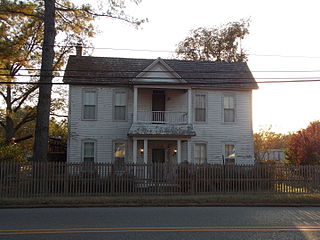
The Luster Urban Farmstead is a historic house at 487 North Central Avenue in Batesville, Arkansas. It is a two-story wood-frame I-house with a rear single-story ell. The main facade is five bays wide, with a central two-story porch. Fishscale shingles provide a decorative element on parts of its walls, and windows have molded hoods. The house was built in 1885 by James Luster, and the property includes a smokehouse, barn, and other outbuildings. It is the only known surviving example of an urban farmstead in Batesville.

The White-Baucum House is a historic house at 201 South Izard Street in Little Rock, Arkansas. It is an L-shaped two story wood frame house, with a hip roof extending over two stories of balconies in the crook of the L, giving the building an overall rectangular footprint. It has Italianate styling, with a bracketed and dentillated eave, spindled porch balustrades, and an elaborate front entry in a round-arch surround. Built in 1869–70, it is one of Arkansas's earliest and finest examples of high style Italianate architecture.
















